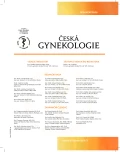Current issues of reproductive medicine in the Czech Republic
Authors:
P. Ventruba 1; J. Žáková 1; M. Ješeta 1; D. Rumpík 2; M. Brandejská 3; I. Crha 1; D. Hlinka 4; L. Jelínková 5; E. Oráčová 6; J. Pavelková 7; K. Řežábek 7; K. Veselá 6
Authors‘ workplace:
Gynekologicko-porodnická klinika LF MU a FN, Brno, přednosta prof. MUDr. P. Ventruba, DrSc., MBA
1; Klinika reprodukční medicíny a gynekologie, Zlín, ředitel MUDr. D. Rumpík
2; Gennet, Praha, ředitel JUDr. M. Stejskal
3; Prague Fertility Centre, Praha, vedoucí MVDr. D. Hlinka, Ph. D.
4; Sanatorium Pronatal, Praha, vedoucí lékař doc. MUDr. T. Mardešić, CSc.
5; Sanatorium REPROMEDA, Brno, ředitelka MUDr. K. Veselá, Ph. D.
6; Gynekologicko-porodnická klinika 1. LF UK a VFN, Praha, přednosta prof. MUDr. A. Martan, DrSc.
7
Published in:
Ceska Gynekol 2016; 81(3): 234-240
Overview
Introduction:
During the 25th symposium of assisted reproduction in Brno was lunch time organised as the lunch table discussion on the selected topics of assisted reproduction. More than 150 specialists reviewed themes related to gynecology and embryology.
Discussed topics:
Lunch table discussion covered the following topics: (1) Cross-border health care in assisted reproduction; (2) Indication for PGS (preimplantation genetic screening) in the context of actual information; (3) Does ovarian stimulation belong to the ambulance of registering gynecologists? (4) Therapy with clomifen – only for IVF specialists? (5) How and with whom should psychological support be directed during IVF? (6) Stimulation in women with low ovarian reserve; (7) Is basic semen analyses sufficient? (8) Time-lapse systems as relevant markers of embryonic development; (9) How to be oriented with choices of media and consumables in the IVF lab, and (10) „Freeze All“ – is this new trend in cryopreservation suitable for all?
Conclusions:
Panel conclusions were presented during the afternoon session, which had great attendance, featured lively commentary, and produced some definitive consensus. Certain issues remained inconclusive, and these matters will be the subject of further discussion in the future. Specific summation of all deductions is presented in this paper.
Keywords:
current topics, assisted reproduction, IVF, round table discussion
Sources
1. Brandes, M., van der Steen, JO., Bokdam, SB., et al. When and why do subferile couples discontinue their fertility care? A longitudinal cohort study in a secondary care subfertility population. Hum Reprod, 2009, 24(12), p. 3127–3135.
2. Walschaerts, M., Bujan, L., Parinaud, J., et al. Treatment discontinuation in couples consulting for male infertility after failing to conceive. Fertil Steril, 2013, 99(5), p. 1319–1323.
3. Oudendijk, JF., Yarde, F., Eijkemans, MJC., et al. The poor responder in IVF: is the prognosis always poor? A systematic review. Hum Reprod Update, 2012, 18(1), p. 1–11.
4. Romany, L., Meseguer, M., Garcia-Herrero, S., et al. Magnetic activated sorting selection (MACS) of non-apoptotic sperm (NAS) improves pregnancy rates in homologous intrauterine insemination (IUI); preliminary data. Fert Steril, 2010, 94(4), p. S14.
5. Meseguer, M., Herrero, J., Tejera A., et al. The use of morphokinetics as a predictor of embryo implantation. Hum Reprod, 2011, 26(10), p. 2658–2671.
6. Zhu, J., Zhuang, X., Chen, L., et al. Effect of embryo culture media on percentage of males at birth. Hum Reprod, 2015, 30(5), p. 1039–1045.
7. Roque, M. Freeze-all policy: is it time for that? J Assist Reprod Genet, 2015, 32(2), p. 171–176.
8. Ventruba, P., Žáková, J., Trávník, P., et al. Aktuální otázky asistované reprodukce v České republice. Čes. Gynek, 2013, 78(4), s. 392–398.
Labels
Paediatric gynaecology Gynaecology and obstetrics Reproduction medicineArticle was published in
Czech Gynaecology

2016 Issue 3
Most read in this issue
- Traumatic symphyseal rupture by vaginal delivery,report of a rare case
- The possibility of antepartal prevention of episiotomy and perineal tears during delivery
- Spontaneus delivery after two previous caesarean sections – case report
- Surgical treatment of endometriomas and ovarian reserve
